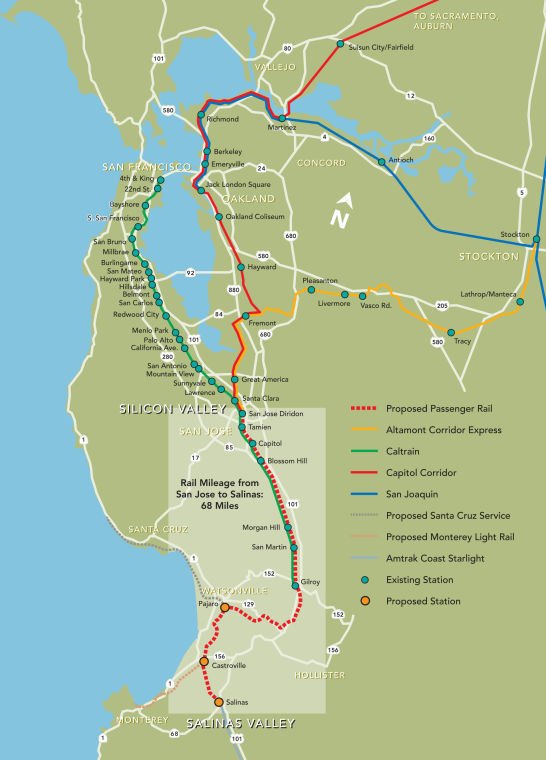South County economic developers are cheerleading Monterey County’s plan to bring train service from Salinas to San Jose, with stops in Gilroy, Morgan Hill and eventually Castroville and Pajaro.
The $135-million project headed up by the Transportation Authority for Monterey County – which would be completed in 2018 – would increase visitor traffic to Gilroy, give residents more alternatives to the chaotic U.S. 101 commute to Silicon Valley and bolster downtown business, according to City staff and Mayor Don Gage.
“More trains, new businesses, fixing the downtown, all the stuff that people have been complaining about for 30 years, it’s getting fixed,” Gage said.
Christina Watson, transportation planner for TAMC, said she plans to collaborate with the cities of Gilroy and Morgan Hill to make the project as seamless as possible. Watson visited the Morgan Hill City Council during their regular meeting on Wednesday night and plans to present information to Gilroy’s City Council during their Oct. 7 meeting.
“We’ve been coordinating (with the City of Gilroy) for years, but now we have a better grasp of the timeline so we’re making sure we keep communicating. So far we’ve heard from them that ‘this is good, this is positive,’” Watson said.
The project would be operated by Sacramento-based Capitol Corridor, which currently offers train service from Sacramento to San Jose. In the beginning years of the Salinas Extension, Capital Corridor will offer two morning trains northbound and two evening trains southbound between Salinas and San Jose seven days a week.
Caltrain currently offers three northbound morning trains and three southbound evening trains between Gilroy and Silicon Valley with stops in San Martin and Morgan Hill, but offers no weekend service to South County. The Salinas Extension won’t be operated by Caltrain, Watson said, but will share the same Union Pacific tracks.
Lee Butler, development center manager for the City of Gilroy, said the project is a game changer in terms of extending the end of the line from Gilroy to Salinas.
“Right now, with us being the end of the line, we have to really be a destination for people to train down here. Being a stop along the middle provides us with more service opportunities and more riders coming through,” Butler said.
The service – which will eventually include stops at the new stations in Castroville and Pajaro – could attract people from the Bay Area who want to spend a weekend in Monterey. TAMC will provide bus service between Monterey and the Castroville stop once it is built (there is currently no timeline).
“People could say, ‘I’m going to go down to Monterey today, and let’s stop and eat lunch in Gilroy on the way,” Butler said.
TAMC estimates that rides between Gilroy and Salinas would be about 50 minutes. The commute from Gilroy to San Jose would be about 30 minutes – a quicker ride than Caltrain’s 51 minute ride.
Leslie Little, Morgan Hill’s assistant manager for community development, said the new Morgan Hill train service will be a great boost to the City’s plans for a thriving, developed downtown.
“It all fits beautifully into where we see the future of Morgan Hill and our downtown,” Little said.
The City of Morgan Hill has already rolled out its plan to increase residential density in downtown, especially near the transit center – to support a robust downtown as well as to promote commuting by train, Little said. Three hundred housing units near the train station (mostly condos and townhouses on Dunne Avenue, Butterfield Boulevard and Depot Street), are either in planning or under construction.
According to Little, the Salinas Extension would help these housing units thrive.
“In terms of our long range planning of being walkable and not needing an automobile to get around, it’s a really valuable project to us,” she said.
Half of the $135 million is secured or requested through various bonds. The largest chunk of money, $18 million, comes from Valley Transportation Authority. The remaining, unfunded $67 million will likely come from federal grants, Watson said.
Gilroy’s Transportation Director, Henry Servine, is pumped that South County residents will have more options for public transportation when the Salinas Extension is complete.
“Have you been on U.S. 101? The back-up used to start at Cochrane (Avenue). Now it’s down to Tennant (Avenue). Jobs are back, and there’s no carpool lane down here so people are driving solo,” Servine said.
One of the more time-consuming aspects of TAMC’s project is building a switcher at Gilroy’s station so that northbound trains can use the platform for boarding, which Servine will help coordinate and plan. The Morgan Hill station does not need any major renovations, Servine said.
Watson said Capitol Corridor predicts about 140,000 annual riders on the two new trains, which Watson said is a “very conservative” estimate.
Tammy Brownlow, president of the Gilroy Economic Development Center – a nonprofit that works in tandem with the Chamber of Commerce to attract new business and economic health to Gilroy – gave accolades for the proposed project.
“I think anything that gives more commute options to people is a good thing for the entire region,” Brownlow said.














